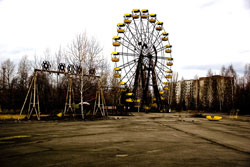 Sorrow in Pripyat Sorrow in Pripyat
On April 26, 1986, there was a sudden explosion. It was just a fire. All fire fighting crews ran to the scene. They all knew about the explosion and the spreading flames. Nobody thought it would be a radioactive catastrophe. People who knew it was a failure had just died from the incident. The recovery effort took all night long. When sunshine appeared, the damage from the incident became horrifyingly apparent.
I want to tell you why this happened. After the Second World War, the USSR and USA were part of a diplomatic challenge called the Cold War. In this period, which concluded with the disintegration of the USSR, both sides were working on nuclear projects. The easiest and cheapest way to obtain the main ingredient of a nuclear weapon is through nuclear reactors. The story begins with one of the reactors located in Pripyat, Chernobyl (Ukraine). The system implemented in these facilities relied on the human factor instead of computerized control units. This put a big responsibility on the shoulders of the plant officials.
 Authorities made a decision about conducting a safety test in the reactor. They wondered how the plant would react in extraordinary conditions such as sudden energy loss. Water is used there for both cooling and transforming thermal energy into electrical energy. A possible lack of electricity affects both the radioactive process and cooling. At this critical point they started the test. They cut the electricity mainstream and waited for the results. However, the auxiliary power unit was activated automatically. They continued the test and increased the water. The core cooled down quickly and decreased the energy. This sudden decrease alerted a worker in another part of the controlling unit. He decreased the number of control rods, which adjust the core temperature, to six. The minimum number of rods should be twenty-six. This caused the uncontrolled and tragic increase in temperature of the core and triggered an increase in water pressure. The cooling unit exploded, damaging the entire structure of the core. The eruption blew out the plant ceiling, aiding the spread of nuclear fallout. In the middle of night, people in Pripyat had no idea what was happening. Authorities made a decision about conducting a safety test in the reactor. They wondered how the plant would react in extraordinary conditions such as sudden energy loss. Water is used there for both cooling and transforming thermal energy into electrical energy. A possible lack of electricity affects both the radioactive process and cooling. At this critical point they started the test. They cut the electricity mainstream and waited for the results. However, the auxiliary power unit was activated automatically. They continued the test and increased the water. The core cooled down quickly and decreased the energy. This sudden decrease alerted a worker in another part of the controlling unit. He decreased the number of control rods, which adjust the core temperature, to six. The minimum number of rods should be twenty-six. This caused the uncontrolled and tragic increase in temperature of the core and triggered an increase in water pressure. The cooling unit exploded, damaging the entire structure of the core. The eruption blew out the plant ceiling, aiding the spread of nuclear fallout. In the middle of night, people in Pripyat had no idea what was happening.
Thousands of people had to deal with the catastrophe, having no idea about the radioactivity. Some lost their lives in a short time. Citizens of Pripyat were forced to leave their houses. The city was evacuated and liquidated in hours. No sign of life was left in the city, where children once played in the parks, where parents strolled the streets.
Neighbor countries in Western Europe, Asia, America and Turkey experienced the aftermath of the Chernobyl incident. Many died, many others struggle with cruel types of cancer. The USSR eventually dissolved, but the pain remains forever in human history. Time was paused, life was abandoned and recovery was slow. All pictures were greyish like hopes and clouds on Pripyat.
BY ÖMER CANBEK ÖNER (CTE/IV)
oner_o@ug.bilkent.edu.tr
 |







